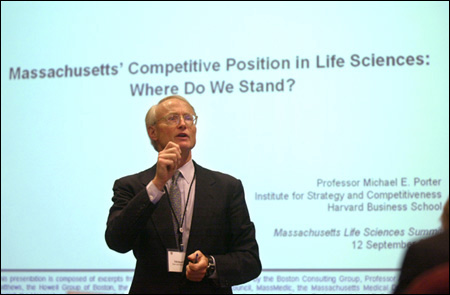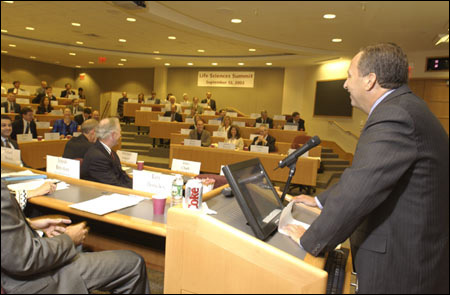Life sciences loom large in Boston’s future:
Harvard summit draws leaders to strategy session

Academic, business, and government leaders sought to forge a collective vision of the life sciences Sept. 12 that would spur collaboration and secure the Boston region’s position as the world’s pre-eminent location for life sciences research, development, and manufacturing.
The gathering, held at Harvard Business School, featured leaders of Harvard, the Massachusetts Institute of Technology (M.I.T.), the University of Massachusetts; local, state, and federal governments; and a host of medical, biotechnology, pharmaceutical, healthcare, and other life sciences-related companies.
Looming large over the gathering was the opportunity presented by the accelerating rate of discovery in the life sciences. Spurred by the recent decoding of the human genome and the rise of new techniques and fields, biomedical researchers are completing in days or weeks work that in the past took years of painstaking trial and error.
Hand in hand with the scientific vision walks an economic one. Massachusetts has a unique collection of universities, hospitals, and talent; the challenge is in harnessing the synergy required to ensure a healthy society, jobs, and a vital economy. Scientific discoveries have spurred new products, treatments, and facilities that have brought jobs to the region. More than one speaker mentioned the region’s once-prominent position in the computer industry, which withered even as Silicon Valley boomed. That happened because local industry pinned its hopes on the minicomputer, a machine that never caught fire in the market and whose capabilities fell between large mainframes and smaller desktop personal computers.
‘The Milestone Symposia: Celebrating the New Research Building at HMS’ will be held Sept. 24-25 in the New Research Building at 77 Ave. Louis Pasteur. Though the Sept 24 event is sold out, limited seating is still available for Sept. 25.
On Sept. 25, beginning at 8:30 a.m., a host of speakers, including Harvard biological chemistry and molecular pharmacology Professors Jon Clardy and Stephen Harrison will discuss ‘Molecular Architecture and Cellular Function.’ Dean of the Harvard Faculty of Medicine Joseph B. Martin will moderate the symposium. Four continuing medical education credits are available to attendees. Online registration is required. For more information, or to register, visit http://www.hms.harvard.edu/milestone.
The five-hour gathering featured a mix of speeches, panels, and question-and-answer-style formats, during which participants discussed setting priorities, removing roadblocks, and facilitating cooperation to boost the industry.
Harvard President Lawrence H. Summers kicked off the “Life Sciences Summit,” with a talk that set the stage for the session and also included four things that Harvard will strive to do to realize the vision.
Summers said that universities and their research play a vital role in the life sciences industry by fueling new inventions, devices, medicines, and treatments. He pledged to increase the emphasis on science and technology in virtually everything Harvard does and repeated his assertion that all students should have a basic scientific education as well as a cultural one.
Summers also said Harvard would increase its attention to applied science, in recognition of the role that solving practical problems has played in scientific innovation over time. Along with that, he said that a specific priority would be to strengthen the Division of Engineering and Applied Sciences.
Fostering collaborative activities of all kinds would also be a priority, Summers said, as a way to encourage specialists from different fields to learn from each other. Summers also said the University needed to strongly support interaction and collaboration with the private sector. He said he and Provost Steven Hyman will be reviewing the University’s intellectual property and technology transfer policies.
Summers strongly cautioned, however, that conflict of interest concerns over commercializing university research are real, and that the University supports broad distribution of research results, an attitude not always shared in the competitive environment of private industry.

“We must be prepared to work cooperatively with the private sector,” Summers said. “Conflict of interest is one side of the coin and synergy is the other side. … We must find our way through these dilemmas with more alacrity than we have in the past.”
Summers said that collaboration from different sectors can help expand an area where Boston is already strong.
“As strong as … the life science cluster is today without combined efforts, it can be far stronger five years from now and still stronger a decade from now,” Summers said.
Michael Porter, Bishop William Lawrence University Professor at Harvard and head of the Business School’s Institute for Strategy and Competitiveness, provided a broad outline of the region’s strengths and weaknesses in the life sciences. At the top was Boston’s existing pre-eminence in the field, providing a strong advantage over the many states, regions, and even other countries that are mounting efforts to build life sciences expertise.
“We don’t have to claw our way to the top,” Porter said. “Our task is to preserve our leadership.”
The region’s advantages, Porter said, include the existing concentration of companies, organizations, and institutions with a presence in the field, the highly educated work force, and the flow of technology among institutions and companies.
Disadvantages include the high cost of living, the high cost of doing business, some infrastructure problems, as well as the difficulty companies face in a sometimes arduous local approval process for new facilities.
Streamlining that site approval process, Porter said, is an important step in landing the manufacturing plants that are the natural outcome of the research and development process.
Though collaboration will be important, M.I.T. President Charles Vest said each sector and organization has a different role to play. The university’s main job is to attract talented faculty and students to an environment that lets them pursue their investigations freely.
Vest said the universities have to become “nimble” – able to shift focus and structure to meet changing needs – and have to continue to attract the federal research dollars that fuel discoveries.
“A central part of our mission as research universities is to allow bright students and faculty to lead the way,” Vest said. “We can’t miss this [opportunity] as we missed the silicon revolution. Jobs and the economy can grow here in Massachusetts or they can flow elsewhere.”




